Ch 6: Mendelian Genetics
1/33
There's no tags or description
Looks like no tags are added yet.
Name | Mastery | Learn | Test | Matching | Spaced |
|---|
No study sessions yet.
34 Terms
What is Darwin’s 4 Postulates (restated in genetic term)?
Allelic variation exists among individuals
Alleles are passed down from parents to offspring by meiosis and fertilization
More young are born that can survive
Some allelic combinations are fitter than others and can reproduce more often
What is Evolution
The change in frequency of alleles in a population over generations

Hardy-Weinberg Equilibrium Principle
Specifies what will happen to the frequencies of alleles and genotypes
(applies to diploid organisms)
Ex. Imagine that mice have a particular locus A w/ 2 alleles: A and a. And they choose their mates randomly from the gene pool
What is population
A group of interbreeding individuals and their offspring
Solve: pt1
60% of eggs and sperm recieved allele A and 40% recieved allele a. When egg and aperm meet, what proportion of genotypes will be AA?
Freq. “A” = 0.6; Freq. “a”= 0.4
60% egg will be “A” and 60% sperm will be A
(0.6)(0.6) = 0.36 × 100% = 36% zygotes will have genotype AA
Solve: pt2
How many would be “aa”?
(0.4)(0.4) = 0.16 × 100%= 16%
Solve: pt.3
How many would be “Aa”?
(0.6)(0.4)(2)=0.48 × 100% = 48%
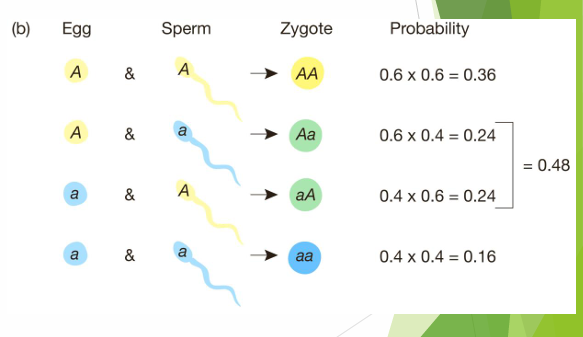
If a population is in Hardy-Weinberg equilibrium, will it evolve?
NO! It will never evolve because the allele frequencies are in equilibrium, so they are the same as in the 1st generation.
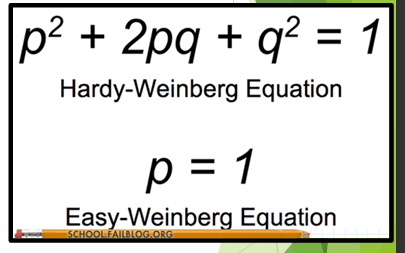
“p” = frequency of allele “A”
“q” = frequency of allele “B”
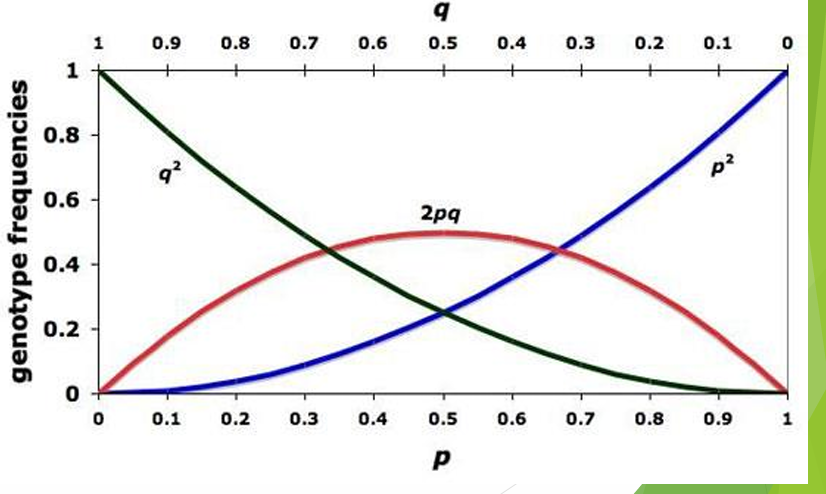
Why do we use Hardy-Weinberg Equilibrium Principle?
to show when evolution does not happen
gives a specific set of testable assumptions
Serves as a null model to test evolution against
Assumptions of Hardy-Weinberg
There is no selection
There is no mutation
There is no migration
There is an infinitely large population size (no random events = no genetic drift)
Mates are chosen randomly (called Panmixia)

The equations allow calculation of allele frequencies (assuming that the population is in Hardy-Weinberg Equilibrium)
By having explicit assumptions….
it can be used to determine which forces are causing disequilibrium
What happens if HWE assumptions are violated?
Evolution!! It occurs when allele frequencies in H-W have changed overtime.
(Remember: Allele frequencies usually should not be able to change in H-W equilibrium)

used to test if Hardy-Weinberg Equilibrium holds or is broken: Chi-squared test
X2 Table
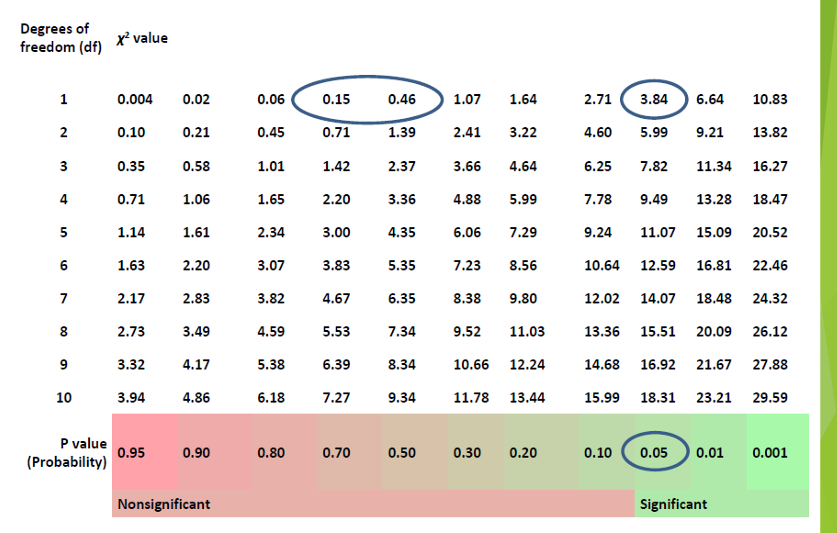
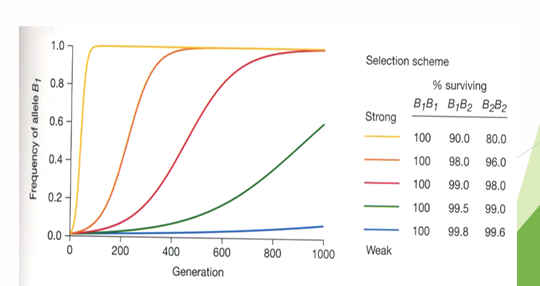
Testing HWE Assumptions: Selection
individuals with particular phenotypes survive to reproduce more than others.
Must be heritable
The population evolved in response to selection
Requires many generations to change allele frequencies
RARELY is selection so strong
Chi-square test example
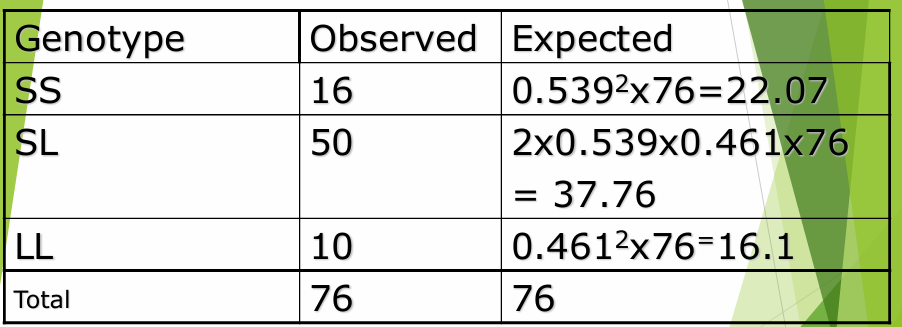
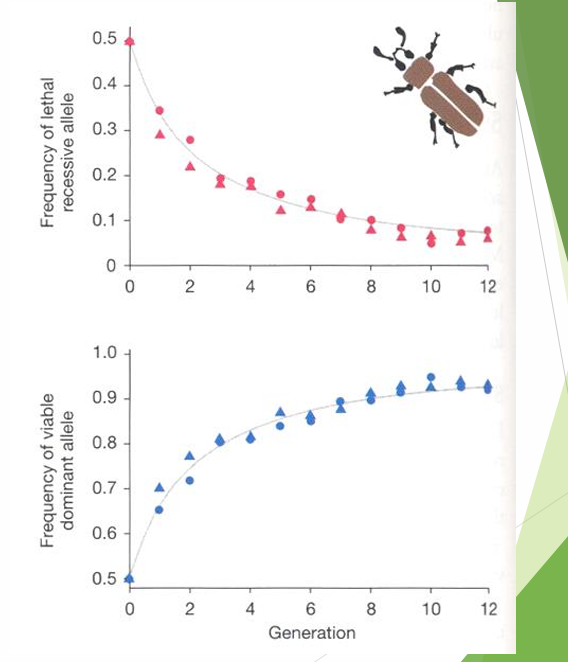
Dominance and allele frequency interaction
If recessive is common = rapid evolution
If recessive is rare = very slow evolution and hidden from selection
Selection coefficient: S = 1 - W
“W” = fitness of an allele (ranges from 0-1)
“S” = strength of selection on an allele
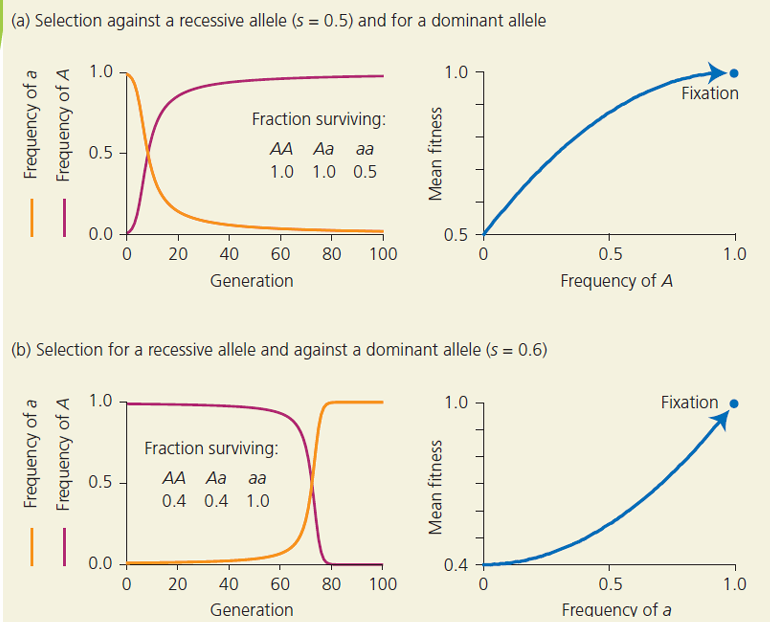
Negative Selection on RECESSIVE phenotypes
w++=1 ; w+1=1 ; wII=1-S
“S” gives strength of selection on the homozygous recessive phenotype
(+)S = in favor of phenotype
(-)S = against phenotype
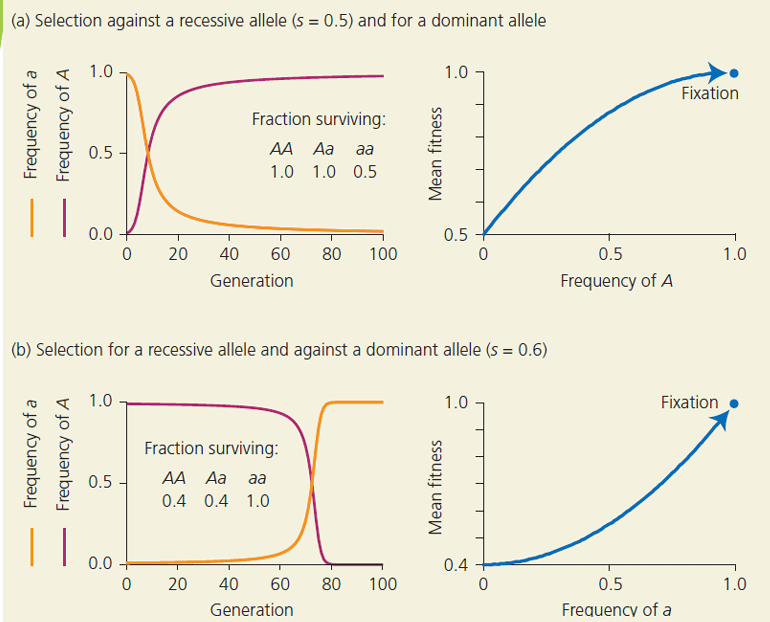
negative selection on DOMINANT phenotypes
w++=1-S ; w+1=1-S ; wII=1
“S” is the amount of selection against phenotype
Heterozygote fitness
when one allele is dominant and one is recessive, the fitness is (=) to that one kind of homozygote
fitness is intermediate to 2 homozygotes
fitness is superior or inferior to either homozygote
Treat chromosomes as alleles: C(2)C(2) and N(2)N(2) genotypes
“C(2)” = compound chromosomes
“N(2)” = normal chromosomes
Populations w/ high C(2) frequency = C(2) rose to fixation
Populations w/ low C(2)” frequency = C(2) was lost
Ex. C(2)C(2) and N(2)N(2) genotypes in Fruit flies
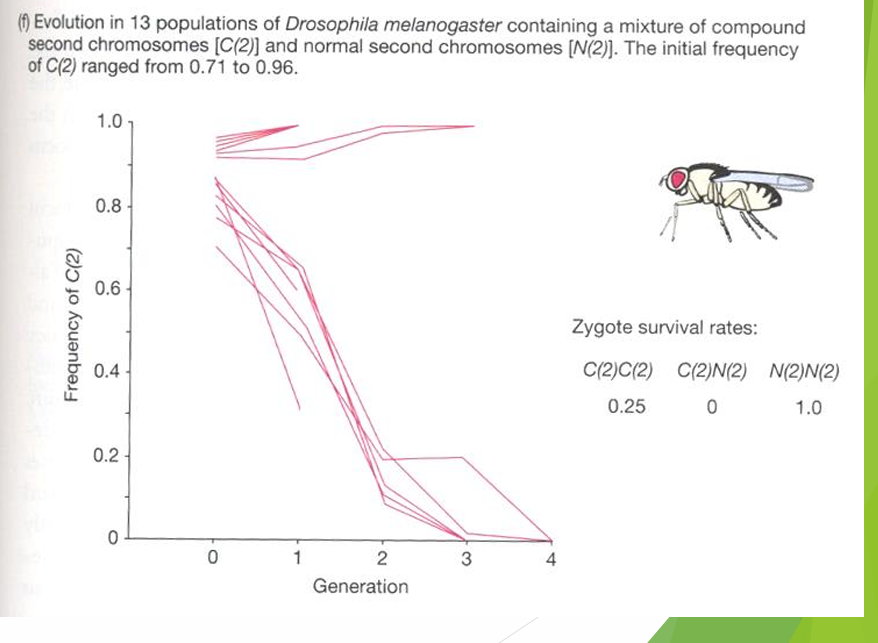
Mean fitness as a function of P: OVER vs. UNDER dominance
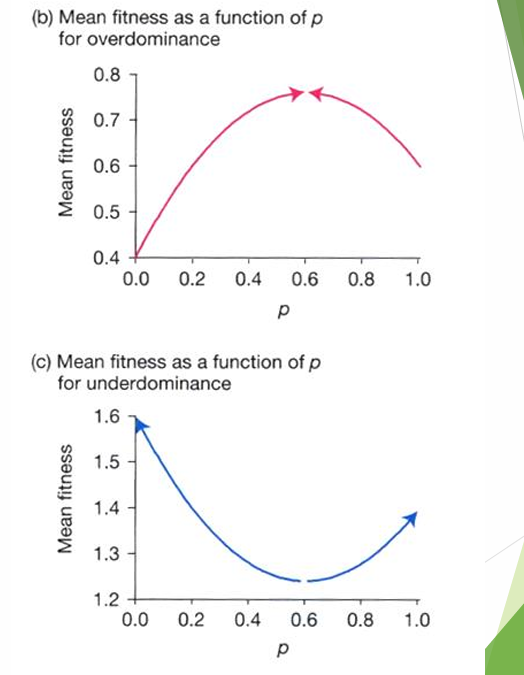
HWE assumptions: Mutation
How effective is mutation as a force of evolution?
A mutation introduces new alleles into a population
Mutation alone is not a potent evolutionary force
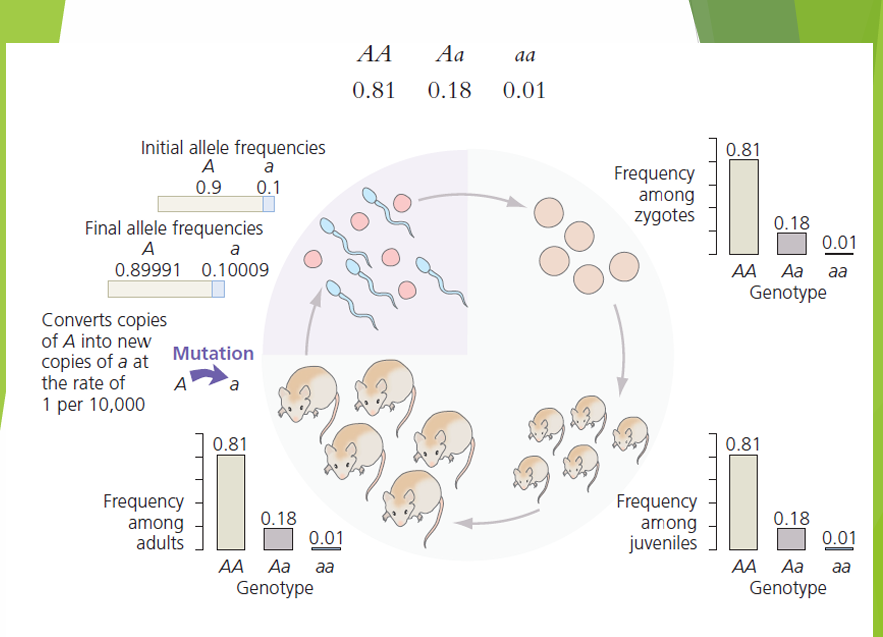
New frequency of A (p) is…
old frequency MINUS fraction LOSTT to mutation
p = 0.9 - (0.0001)(0.9)
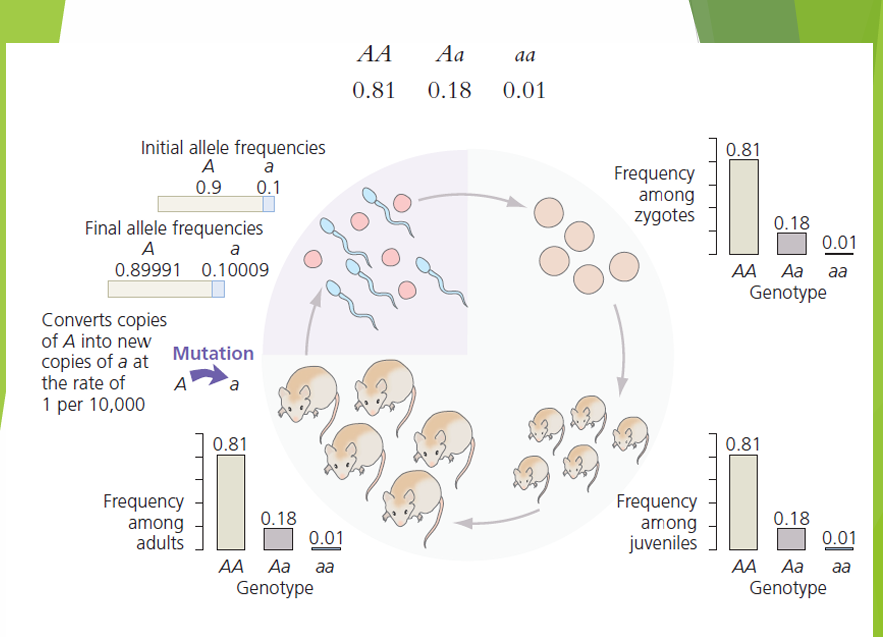
New frequency of a (q) is…
old frequency PLUS fraction GAINED by mutation
q= 0.1 + (0.0001)(0.9)
Particular mutation rate?
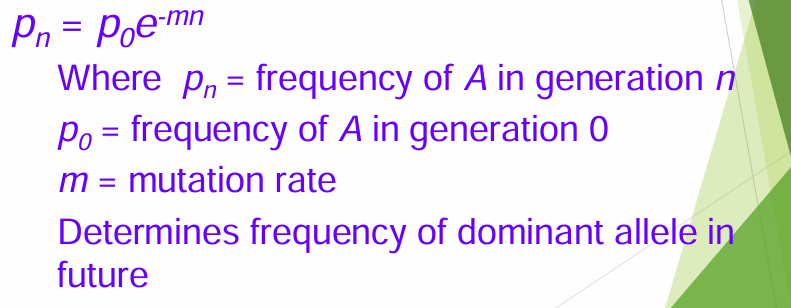
Can mutation alone cause great changes in allele frequencies?
No, but it is still important in evolution. Mutation can be a potent evolutionary force
Lenski’s E. coli study
After growing billions of cells, they removed approximately 5 million cells from each and transferred them to a new medium.
Fitness and cell size increased in response to natural selection
Fitness increases occurred in jumps
Beneficial mutations swept through the population to fixation
Mutations caused bacteria to divide faster and increase in size
Mutation is ultimate source of genetic variation
Mutation Selection Balance
Mutation is the ULTIMATE source of genetic variation
Most mutations are deleterious
Selection eliminates these mutations
Mutations are created anew

Deleterious Recessive allele at equilibrium
If selection is SMALL and mutation is HIGH, the equilibrium frequency of the allele will be high
If selection is HIGH and mutations are LOW, equilibrium frequency will be low